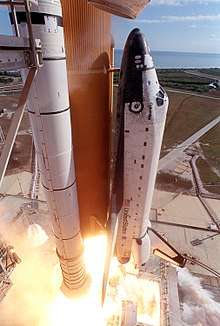Spaceworthiness
Spaceworthiness,[1][2] or aerospaceworthiness,[3] is a property, or ability of a spacecraft to perform to its design objectives and navigate successfully through both the space environment and the atmosphere as a part of a journey to or from space.

Space Shuttle Columbia, thought to be spaceworthy despite damage incurred during this liftoff, was destroyed by it upon re-entry.
As in airworthiness, the spaceworthiness of a spacecraft depends on at least three basic components:[4][5]
- design of the spacecraft, which covers activities of engineering evaluation, simulations, laboratory and prototype tests,[6][7] and experimental flights;
- production, which seeks to ensure that the spacecraft has been assembled in conformity with the design specification;
- maintenance of the spacecraft, after production, before and during each flight mission.
Spaceworthiness is typically maintained through a maintenance program and / or a system of analysis, diagnosis and management of health and reliability of the spacecraft.[8][9][10][11][12]
Related concepts
Spaceworthiness of launch vehicles and spacecraft is an extension of the concepts of roadworthiness for cars, railworthiness for trains, seaworthiness for boats and ships, and airworthiness for aircraft.
gollark: Though I looked at it a while ago and silicon or germanium might be better.
gollark: Loads of things. The highest-density is data encoded in big diamonds through different isotopes of carbon.
gollark: I mean, if it's fun, why not, but I don't think it's the most effective way to preserve data.
gollark: I prefer to etch my important data on the moon with lasers.
gollark: This is why you have backups.
See also
References
- Scientific Assessment of Options for the Disposal of the Galileo Spacecraft (search with CTRL+F for "Galileo's general spaceworthiness"). The National Academies Press. (accessed August 12, 2010)
- Tatsuya, Maruyama (Kawasaki Heavy Ind., Ltd., Gifu-pref., Jpn). "Reconsideration on space tour vehicle "KANKOH-MARU" from the standpoint of safety standard". Japanese Rocket Society's Rocket Symposia 1995-2001 - With an Overview of Japanese Rocket Society's Space Tourism Study. J Space Technol Sci. Vol. 19, no.1, page 11-16(2003). Abstract published on "Science Links Japan" site. (accessed August 12, 2010)
- Scott, H.A. "Spaceworthiness Exists" (search with CTRL+F for "spaceworthiness"). "Aviation Week" site. February 22, 2010.
- Funatsu, Yoshi. "Some Aspects of Space Navigation Law" (in: sub-item 3, "Safety of space vehicles", of item 2, "Outline of Commercial Space Law"). Proceedings of 2nd International Symposium on Space Travel, Space Tours GmbH, in press. Space Future Site. (visited on Aug 12, 2010)
- 16th Space Simulation Conference (microform): confirming spaceworthiness into the next millennium / Joseph L. Stecher III, editor. By Space Simulation Conference (16th : 1990 : Albuquerque, N.M.). Subjects: - Space simulators - Congresses; - Space environment - Congresses; Space vehicles -- Testing -- Congresses. NASA conference publication; 3096. Greenbelt, Md. : National Aeronautics and Space Administration, Goddard Space Flight Center ; (Springfield, Va. : For sale by the National Technical Information Service, 1991). (visited on Aug 12, 2010)
- David Florida Laboratory Activities: "The David Florida Laboratory (DFL) supplies government and industry with the specialized rooms, equipment, and support personnel necessary to assemble and check the spaceworthiness of entire spacecraft, their subsystems, and major components". Canadian Space Agency. (visited on Aug 12, 2010)
- NASA Delays Shuttle Mission to Hubble Telescope (search with CTRL+F for "tests required to prove its spaceworthiness"). Space.com site. (visited on Aug 12, 2010)]
- Wolfgang Ecke et al. Fibre optic sensor network for spacecraft health monitoring. 2001 Meas. Sci. Technol. 12 974. (visited on Jan 28, 2011)
- W.J. Staszewski, C. Boller, G.R. Tomlinson (Editors). Health Monitoring of Aerosapace Structures: Smart Sensor Technologies and Signal Processing. John Wiley & Sons. Wiley Online Library, 10 Feb 2004. Print ISBN 978-0-470-84340-6. Online ISBN 978-0-470-09286-6. doi:10.1002/0470092866. (visited on Jan 28, 2011)
- HUMS: Health And Usage Monitoring Systems. Aviation Maintenance. Feb 1, 2006. (visited on Jan 28, 2011)
- "Health and Usage Monitoring Systems (HUMS) are integrated with aircraft management computers to allow maintainers early warnings of parts that will need replacement". Aircraft management systems. Avionics. Wikipedia. (visited on Aug 12,2010)
- Cronkhite, J.; Dickson, B.; Martin, W.; Collingwood, G. "Operational Evaluation of a Health and Usage Monitoring System (HUMS)" (Diagnostics; Vibration measurement; Helicopters; Health and usage monitoring). Archived 2010-07-25 at the Wayback Machine NASA Glenn Technical Reports Server. (visited on Aug 12, 2010)
This article is issued from Wikipedia. The text is licensed under Creative Commons - Attribution - Sharealike. Additional terms may apply for the media files.